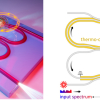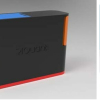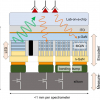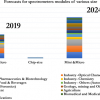
Coherent extreme ultraviolet (XUV) and soft X-ray radiation are very powerful in studying various material properties in biology, chemistry and physics. Synchrotron radiation (SR) and X-ray free electron lasers (XFEL) can provide XUV and X-ray radiation. Although SR allows multi-port operation with a MHz repetition rate, the pulse duration is several tens of ps with no temporal coherence. While XFEL can provide high intensity fs XUV pulse, multi-port and high-repetition rated operations are limited.
The high-order harmonic (HH) pulse of an intense femtosecond laser generated upon its interaction with a gas medium has been expected to be another coherent XUV light source, filling a gap between SR and XFEL with much more compact size. During the last two decades, the development of HH sources has progressed, strongly supported by the progress of intense femtosecond laser technology. However, the repetition rate of the HH pulse, limited by the repetition rate of the fundamental laser system, is still insufficient for novel applications, such as ultrafast XUV spectroscopy, photoelectron spectroscopy and coincidence measurements.
In a new paper published in Light Science & Application, a team of scientists, led by Dr Katsumi Midorikawa from RIKEN Center for Advanced Photonics, Japan, has developed a novel ultrafast coherent light source in the extreme ultraviolet (XUV) wavelength region with multi-MHz range repetition rates by utilising intracavity high-order harmonic generation (HHG) in a Yb:YAG thin-disk mode-locked oscillator. To date, the highest repetition rates of existing HH XUV light sources have usually been limited to less than 100 kHz. This is due to the fact that a huge average power of more than 1 kW (~1 mJ pulse energy and ~1 MHz repetition rate) of the driving fundamental femtosecond pulses is typically required for realising such a specification. To overcome this difficulty, the authors took a unique approach.
The system is based on HHG inside the cavity of a high-energy mode-locked ring oscillator with a repetition rate of 3 MHz using an Yb:YAG thin disk laser as a gain medium. A schematic diagram of the system is shown in part a of the figure. The first breakthrough in the new XUV source is that the laser intensity in the cavity is sufficiently high to saturate the highest cut-off photon energy of HHG from an Ar gas target with a high degree of ionisation. Technical challenges to achieving high-intensity pulses inside the cavity, such as the careful design of a 100-m-long ring cavity and the cooling system of optics in a vacuum chamber (see part b of the figure), led to stable long-term operation. A repetition rate of 3 MHz, which is desired for avoiding HHG degradation caused by cumulative ionisation effects of gas targets, is suitable for the potential applications. The second point is the multiport HHG. We simultaneously obtained the HHG from a Ne gas target and that from an Ar gas target injected in two different foci in the cavity. This is due to the robustness of the mode-locked oscillator against the non-linear phase shifts in the target gas media compared with enhancement cavities used for HHG, which is generally fragile against perturbations. We expect to increase further the number of HHG ports by careful dispersion management of the fundamental pulse and enhancement of target gas evacuation capacity in the cavity.
Future developments of gain medium with broader gain bandwidth, for example, Yb:Lu2O3 or Yb:CALGO, would enable shorter pulse duration and enhance HHG efficiency. Besides much higher power operation would be obtained by using zero-phonon line pump lasers and compensation of heat deformation of thin disk wave plane with deformable mirrors. Furthermore, the decrease of laser output coupling would improve a wall-plug efficiency, because this scheme needs no laser output from the cavity in principle. Our method paves the way to MHz repetition-rate high-power XUV sources for multi-user or multi-colour facility and should contribute to ultrafast XUV spectroscopy in material science.













